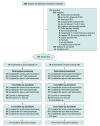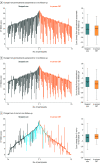Effect of an Internet-Delivered Stepped-Care Program vs In-Person Cognitive Behavioral Therapy on Obsessive-Compulsive Disorder Symptoms in Children and Adolescents: A Randomized Clinical Trial
- PMID: 33974020
- PMCID: PMC8114140
- DOI: 10.1001/jama.2021.3839
Effect of an Internet-Delivered Stepped-Care Program vs In-Person Cognitive Behavioral Therapy on Obsessive-Compulsive Disorder Symptoms in Children and Adolescents: A Randomized Clinical Trial
Abstract
Importance: In most countries, young people with obsessive-compulsive disorder have limited access to specialist cognitive behavioral therapy (CBT), a first-line treatment.
Objective: To investigate whether internet-delivered CBT implemented in a stepped-care model is noninferior to in-person CBT for pediatric obsessive-compulsive disorder.
Design, setting and participants: A randomized clinical noninferiority trial conducted at 2 specialist child and adolescent mental health clinics in Sweden. Participants included 152 individuals aged 8 to 17 years with obsessive-compulsive disorder. Enrollment began in October 2017 and ended in May 2019. Follow-up ended in April 2020.
Interventions: Participants randomized to the stepped-care group (n = 74) received internet-delivered CBT for 16 weeks. Nonresponders at the 3-month follow-up were then offered a course of traditional face-to-face treatment. Participants randomized to the control group (n = 78) immediately received in-person CBT for 16 weeks. Nonresponders at the 3-month follow-up received additional face-to-face treatment.
Main outcomes and measures: The primary outcome was the masked assessor-rated Children's Yale-Brown Obsessive-Compulsive Scale (CY-BOCS) score at the 6-month follow-up. The scale includes 10 items rated from 0 (no symptoms) to 4 (extreme symptoms), yielding a total score range of 0 to 40, with higher scores indicating greater severity. Assessors were masked to treatment allocation at pretreatment, posttreatment, 3-month follow-up, and 6-month follow-up assessments. The predefined noninferiority margin was 4 points on the CY-BOCS.
Results: Among the 152 randomized participants (mean age, 13.4 years; 94 [62%] females), 151 (99%) completed the trial. At the 3-month follow-up, 34 participants (46%) in the stepped-care group and 23 (30%) in the in-person CBT group were nonresponders. At the 6-month follow-up, the CY-BOCS score was 11.57 points in the stepped-care group vs 10.57 points in the face-to-face treatment group, corresponding to an estimated mean difference of 0.91 points ([1-sided 97.5% CI, -∞ to 3.28]; P for noninferiority = .02). Increased anxiety (30%-36%) and depressive symptoms (20%-28%) were the most frequently reported adverse events in both groups. There were 2 unrelated serious adverse events (1 in each group).
Conclusions and relevance: Among children and adolescents with obsessive-compulsive disorder, treatment with an internet-delivered CBT program followed by in-person CBT if necessary compared with in-person CBT alone resulted in a noninferior difference in symptoms at the 6-month follow-up. Further research is needed to understand the durability and generalizability of these findings.
Trial registration: ClinicalTrials.gov Identifier: NCT03263546.
Conflict of interest statement
Figures



Comment in
- doi: 10.1001/jama.2021.5047
Similar articles
-
Stepped Care Internet-Delivered vs Face-to-Face Cognitive-Behavior Therapy for Pediatric Obsessive-Compulsive Disorder: A Trial Protocol for a Randomized Noninferiority Trial.JAMA Netw Open. 2019 Oct 2;2(10):e1913810. doi: 10.1001/jamanetworkopen.2019.13810. JAMA Netw Open. 2019. PMID: 31642928 Free PMC article. Clinical Trial.
-
Cost-effectiveness of Internet-Delivered vs In-Person Cognitive Behavioral Therapy for Children and Adolescents With Obsessive-Compulsive Disorder.JAMA Netw Open. 2021 Jul 1;4(7):e2118516. doi: 10.1001/jamanetworkopen.2021.18516. JAMA Netw Open. 2021. PMID: 34328501 Free PMC article.
-
Effect of Internet-Based vs Face-to-Face Cognitive Behavioral Therapy for Adults With Obsessive-Compulsive Disorder: A Randomized Clinical Trial.JAMA Netw Open. 2022 Mar 1;5(3):e221967. doi: 10.1001/jamanetworkopen.2022.1967. JAMA Netw Open. 2022. PMID: 35285923 Free PMC article. Clinical Trial.
-
Acceptability, feasibility, and efficacy of Internet cognitive behavioral therapy (iCBT) for pediatric obsessive-compulsive disorder: a systematic review.Syst Rev. 2019 Nov 20;8(1):284. doi: 10.1186/s13643-019-1166-6. Syst Rev. 2019. PMID: 31747935 Free PMC article.
-
Efficacy and acceptability of cognitive-behavioral therapy and serotonin reuptake inhibitors for pediatric obsessive-compulsive disorder: a network meta-analysis.J Child Psychol Psychiatry. 2024 May;65(5):594-609. doi: 10.1111/jcpp.13934. Epub 2024 Jan 3. J Child Psychol Psychiatry. 2024. PMID: 38171647 Review.
Cited by
-
Online Interventions for Family Carers of People with Dementia That Focus on Support Strategies for Daily Living: A Mixed Methods Systematic Review.Behav Sci (Basel). 2025 Jun 25;15(7):863. doi: 10.3390/bs15070863. Behav Sci (Basel). 2025. PMID: 40723647 Free PMC article. Review.
-
Adverse events in cognitive behavioral therapy and relaxation training for children and adolescents with obsessive-compulsive disorder: A mixed methods study and analysis plan for the TECTO trial.Contemp Clin Trials Commun. 2023 Jun 20;34:101173. doi: 10.1016/j.conctc.2023.101173. eCollection 2023 Aug. Contemp Clin Trials Commun. 2023. PMID: 37497354 Free PMC article.
-
Therapist-guided, Internet-delivered cognitive behaviour therapy for adolescents with body dysmorphic disorder: A feasibility trial with long-term follow-up.Internet Interv. 2023 Nov 16;34:100688. doi: 10.1016/j.invent.2023.100688. eCollection 2023 Dec. Internet Interv. 2023. PMID: 38034863 Free PMC article.
-
Long-term effect of stepped-care vs in-person cognitive behavioral therapy for pediatric obsessive-compulsive disorder.Internet Interv. 2023 Mar 15;32:100613. doi: 10.1016/j.invent.2023.100613. eCollection 2023 Apr. Internet Interv. 2023. PMID: 37033903 Free PMC article.
-
Feasibility of internet-delivered cognitive-behavior therapy for obsessive-compulsive disorder in youth with autism spectrum disorder: A clinical benchmark study.Internet Interv. 2022 Mar 4;28:100520. doi: 10.1016/j.invent.2022.100520. eCollection 2022 Apr. Internet Interv. 2022. PMID: 35281701 Free PMC article.
References
-
- Pérez-Vigil A, Fernández de la Cruz L, Brander G, et al. . Association of obsessive-compulsive disorder with objective indicators of educational attainment: a nationwide register-based sibling control study. JAMA Psychiatry. 2018;75(1):47-55. doi:10.1001/jamapsychiatry.2017.3523 - DOI - PMC - PubMed
Publication types
MeSH terms
Associated data
LinkOut - more resources
Full Text Sources
Other Literature Sources
Medical
Miscellaneous

